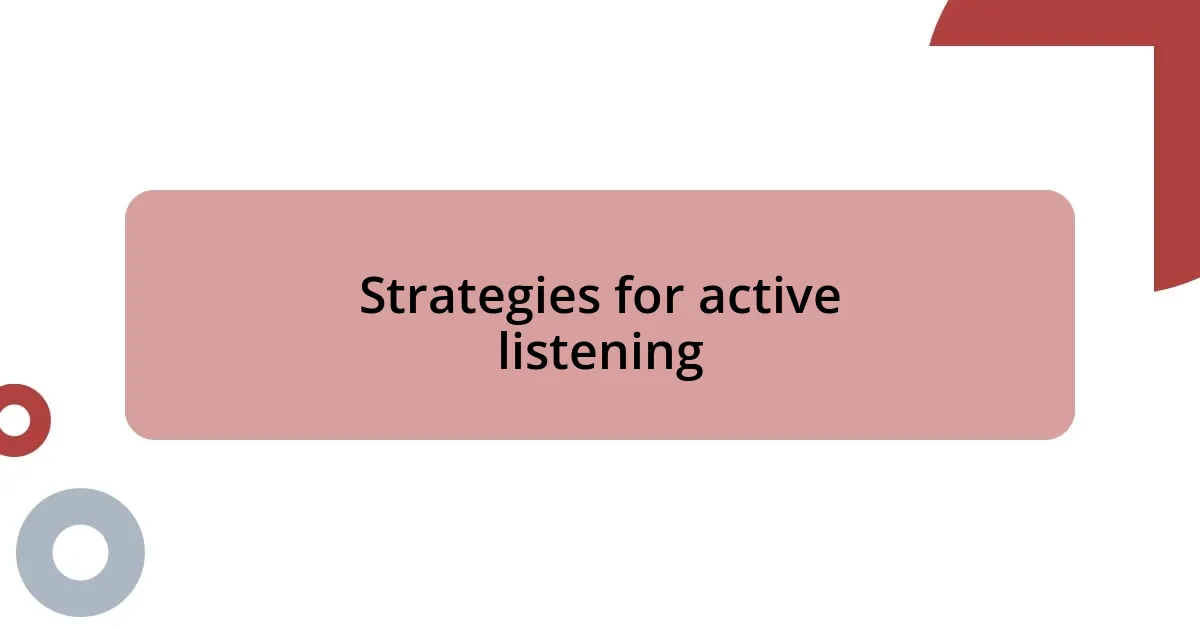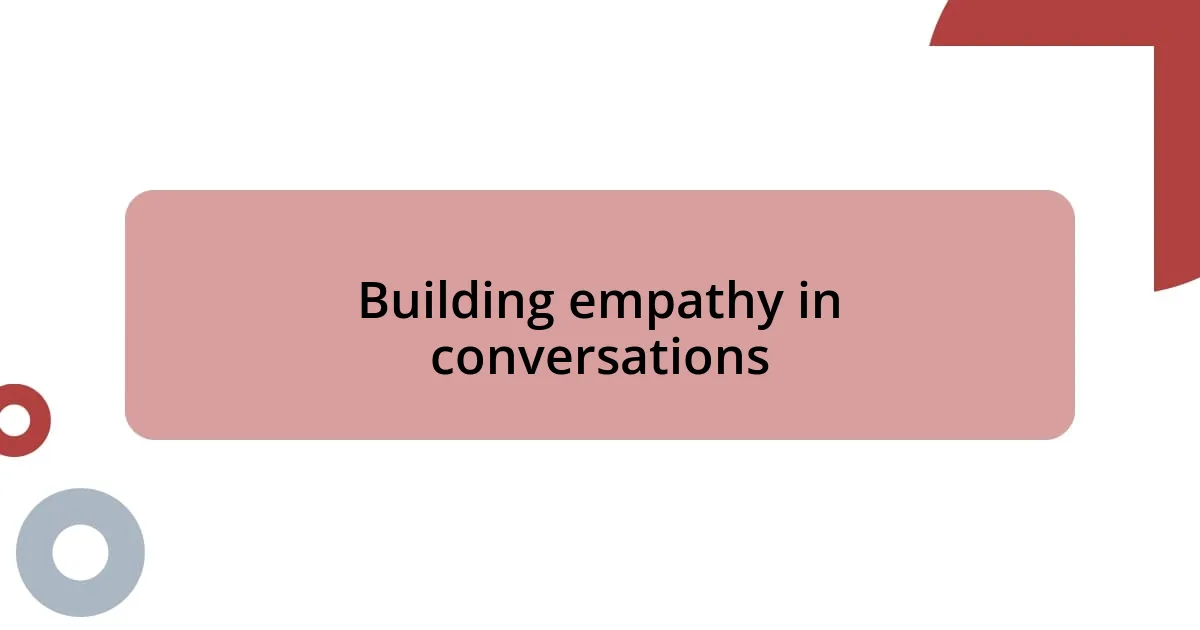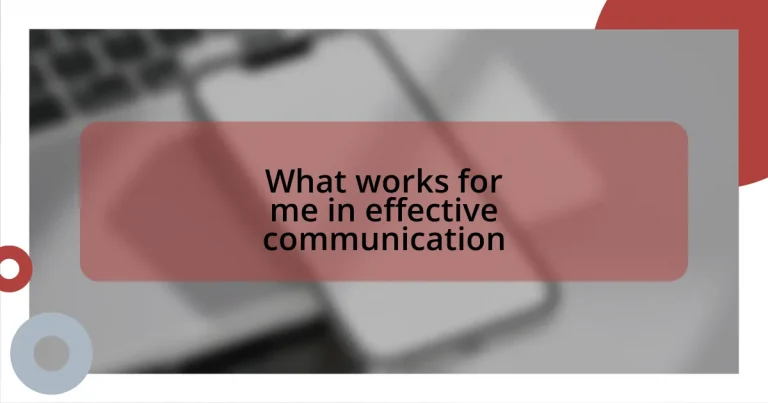Key takeaways:
- Effective communication involves clarity, empathy, and feedback to foster deeper connections and understanding.
- Active listening strategies, like maintaining eye contact and reflecting back what you hear, enhance engagement and clarity in conversations.
- Building empathy requires not just listening to words but also understanding emotions, allowing for more meaningful dialogues.
- Continuous improvement in communication skills involves seeking feedback, practicing active listening, and reflecting on past interactions to learn and grow.

Understanding effective communication
Effective communication is about more than simply exchanging information; it’s about connecting with others on a deeper level. I remember a time during a team project when, instead of just sending emails, I organized face-to-face meetings. Those conversations broke down barriers and fostered collaboration that email threads just couldn’t achieve. Have you ever noticed how body language and tone can completely shift the meaning of words?
Listening is a critical component that often gets overlooked. I’ve found that when I genuinely listen to others, it transforms the conversation. Once, a colleague shared a personal story that illuminated her perspective on a project. It resonated with me and shifted my approach. Isn’t it fascinating how being open to another’s experience can lead to more profound understanding?
Additionally, clarity in our messages is essential. I’ve learned this the hard way—miscommunication can lead to frustration. There was a moment when I misunderstood instructions, which caused delays. This experience taught me the importance of asking questions and confirming understanding. How do you ensure clarity in your communication with others?

Key principles of effective communication
Effective communication hinges on clarity and simplicity. I recall a meeting where a colleague presented a complex idea using technical jargon, only to lose half of the room’s attention. That experience reinforced how using straightforward language can keep everyone on the same page. Have you ever found yourself nodding in agreement while having no clue what was said? Simplifying language helps us connect and ensures the message hits home.
Another key principle is empathy. I once had a conversation with an upset team member about a project’s direction, and instead of reacting defensively, I chose to understand their concerns. By showing genuine care for their emotions, we built rapport and found common ground. This experience made me realize that empathy turns a regular discussion into a meaningful exchange. Can you think of a moment when empathizing changed the course of a conversation for you?
Finally, feedback plays a crucial role in effective communication. I’ve made it a point to seek and give feedback after discussions. For instance, after a recent presentation, I asked my team for their thoughts—not just on the content, but on my delivery. Their insights helped me improve significantly for future presentations. Why do you think feedback is often overlooked in communication?
| Key Principle | Description |
|---|---|
| Clarity | Using simple language to ensure understanding. |
| Empathy | Understanding and connecting with others’ feelings. |
| Feedback | Seeking and offering constructive criticism to enhance communication. |

Strategies for active listening
Effective active listening requires a conscious effort to engage deeply with the speaker. I’ve experienced moments when I let my mind wander during a conversation, only to realize later that I missed crucial details. By maintaining eye contact and nodding along, I’ve found that not only do I retain more information, but the speaker feels heard and valued.
Here are some strategies that have worked for me:
- Focus on the Speaker: Put away distractions, like your phone, to show that you’re fully present.
- Reflect and Clarify: After listening, I often summarize what I heard to ensure I understood correctly. This not only validates the speaker but also enhances my understanding.
- Ask Open-Ended Questions: Engaging others with open-ended questions encourages them to share more, which enhances the conversation. For example, instead of asking if they liked a solution, I might ask what they thought about it.
By implementing these strategies, I’ve built stronger connections and fostered deeper conversations, making my interactions not just more effective, but more fulfilling.

Building empathy in conversations
When building empathy in conversations, it’s essential to listen intently—not just to the words, but to the emotions behind them. I remember a time when a friend opened up about their struggles at work. Instead of jumping in with my own experiences or solutions, I made a point to simply listen and acknowledge their feelings. That moment of patience opened the door to a deeper connection, transforming what could have been a casual chat into a supportive dialogue. Have you noticed how a heartfelt “I understand” can change the entire tone of a conversation?
Being vulnerable also plays a crucial role in fostering empathy. When I shared my own vulnerabilities in discussions, like a recent failure, it encouraged others to share openly too. This mutual exchange creates a safe space where emotions aren’t just acknowledged but explored together. I often think, how many times has sharing a personal experience helped others feel comfortable enough to express their own?
Another strategy is to ask poignant questions that invite the other person to elaborate on their feelings. For instance, I once asked a colleague how they were truly feeling about an upcoming project deadline, rather than just how they were managing it. This simple shift in questioning allowed them to express not only their stress but also their hopes for the project. It made me realize that sometimes, all it takes to build empathy is the courage to dig a little deeper, and that willingness can truly enrich our conversations.

Techniques for clear expression
When it comes to clear expression, one key technique I’ve found invaluable is using simple language. I recall a meeting where technical jargon flew around like confetti, leaving many, including myself, utterly confused. Now, I make it a point to replace complex terms with straightforward ones. The goal should always be clarity, not complexity—have you ever noticed how much smoother a conversation flows when everyone is on the same page?
Another technique I swear by is the power of pauses. I’ve learned that taking a moment after speaking allows your message to settle. During a recent workshop, I noticed how the tension in the room eased when I paused after key points. It gave everyone time to digest what I said, prompting thoughtful responses. Isn’t it fascinating how silence can enhance understanding?
Lastly, I find that visual aids greatly enhance my expression of ideas. I love incorporating visuals, like charts or images, to illustrate key points. For instance, during a project presentation, I used a simple graph to show progress over time. The visual helped clarify my message in a way that words alone struggled to do. Have you ever experienced a moment where a picture truly was worth a thousand words? It’s these techniques that make my message resonate more deeply and clearly with others.

Overcoming communication barriers
Overcoming communication barriers is often a matter of actively recognizing and addressing them. I remember a instance when a colleague and I were struggling to understand each other’s points during a discussion, largely due to different communication styles. It clicked for me that adapting my approach—slowing down my pace and simplifying my vocabulary—was key to bridging that gap. Isn’t it interesting how small adjustments can lead to such significant shifts in understanding?
Another barrier I’ve encountered is the emotional distance that can arise during difficult conversations. Recently, I had to talk to a friend about a falling out we’d had. Instead of approaching the conversation with defensiveness, I chose to express my feelings openly and respectfully. This choice transformed what could have been an argument into an open dialogue. It made me reflect: how often do we let fear of confrontation hold us back from enriching our relationships?
Finally, I’ve learned that non-verbal cues play a crucial role in overcoming barriers. During a tense meeting, I noticed my body language was closed off, which likely made others feel hesitant to engage. I consciously shifted my posture to be more open and inviting, and immediately felt the tension lighten. It prompts me to ask—how aware are we of the unspoken messages we send in our interactions? Emphasizing those subtle cues can truly enhance our communication effectiveness.

Continuous improvement in communication skills
Continuous improvement in communication skills is something I truly believe is a lifelong journey. I recall when I started my career, I found myself feeling intimidated during presentations. To combat this, I began seeking out feedback from my peers after each talk. Their suggestions not only bolstered my confidence but also showed me how valuable it is to view communication as an evolving skill. Have you ever asked for feedback and been surprised by the insights you gained?
Another practice I embrace is regularly engaging in active listening. It’s easy to fall into the trap of waiting for your turn to speak, but I’ve discovered that genuinely focusing on others fosters deeper connections. I remember a conversation I had with a mentor where I left feeling understood and valued, simply because I took the time to listen. This experience taught me that listening is just as critical as expressing oneself—how often do we overlook that simple act?
Lastly, I like to reflect on my communication experiences. After a challenging conversation, I often take a moment to analyze what went well and what didn’t. This practice turns my mistakes into learning opportunities. For instance, after a recent team meeting, I realized that my enthusiasm sometimes overshadowed others’ contributions. Recognizing this allowed me to adjust my approach in future discussions. Isn’t it amazing how self-reflection can unlock new levels of understanding?














